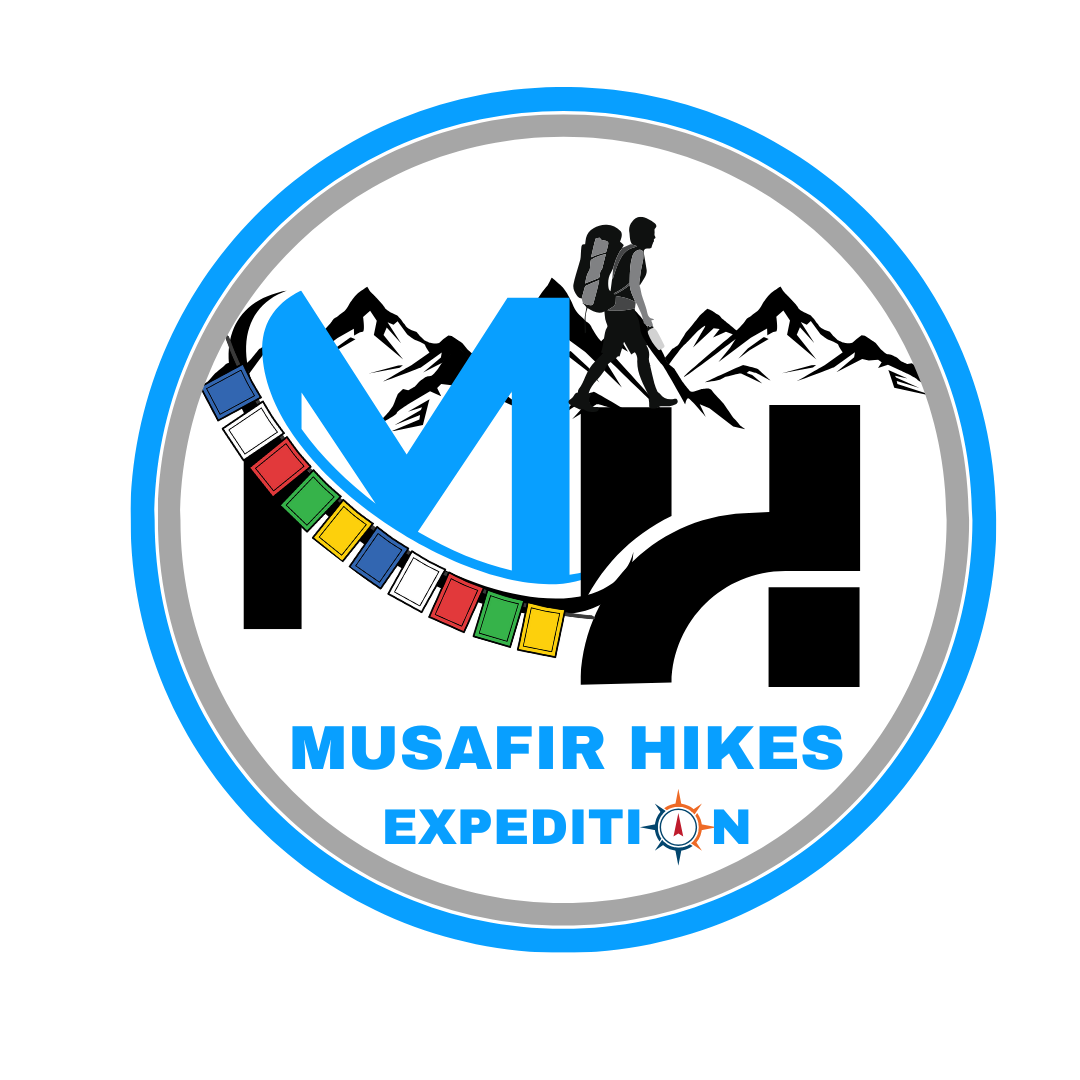Region
Uttrakhand | India
Duration
8 Days
Max. Altitude
11,482 ft.
Trekking Km.
36 kms
Grade
Easy To Moderate
Get in Touch with Our Trek Expert
- 91-9634395113
- info@musafirhikes.com
- Monday - Saturday: 10 AM to 06 PM
Rs. 12,000 /Person
Fixed Departure Dates
Sept 2025
- 5% GST will be applicable on Trek Cost and Add-ons.
- Meeting Point( Pickup/ Drop Point ): Hotel Milan Palace near Railway Station,Dehradun.
- Reporting Time: 6:00 am
- Drop Time: 6:30 pm to 7:30 pm (Timings are subject to change based on weather and road conditions).
- Please reach Dehradun a day before to avoid any delays.
Overview
A serene glacial lake situated at an altitude of 3,500 m at the foot of Kalanag (Black Peak). Located near the source of the Supin River, this lake is considered sacred due to its association with the mythological tales of the Mahabharata. The lake stretches for about 1.7 km, surrounded by dense alpine meadows and towering Himalayan peaks, making it a tranquil and pristine destination for trekkers and nature lovers.
The trek lies within Govind National Park in Uttarkashi, a region renowned for its rich flora and fauna. Along the way, you’ll pass through untouched meadows, shepherd pastures, and quaint villages before the trail eventually leads towards Bali Pass.
The basecamp for the trek is Sankri, a culturally rich Himalayan village that also serves as the starting point for other popular treks. With its traditional charm and breathtaking landscapes, Sankri offers explorers an authentic experience of Garhwal’s mountain life.
Why Choose Ruinsara Lake Trek?
Continue Reading....
Spectacular Views of Snow-Capped Peaks
The lake is surrounded by high Himalayan peaks, offering mesmerizing views of Swargarohini ranges, Bandarpoonch, and Black Peak (Kalanag). The constantly shifting shades of these peaks in sunrise and sunset light make this trek unforgettable.
Ancient Villages En Route
The trail passes through charming Himalayan villages such as Dhatmir, Puwani, Gangad, and Osla, where time seems to have stood still. These villages are adorned with wooden houses, traditional temples, and unique architecture.
The rich culture, warm hospitality, and distinct language and attire of the locals make the journey culturally immersive. Trekkers also get the chance to interact directly with villagers, gaining insights into their traditions and way of life.
Who Can Participate
- Age Requirements:
- April to November: 9 years.
- December to March: 11 years.
- First-timers are welcome, though prior trekking experience is preferred. Good fitness is a must.
- Fitness Criteria:
- The Trekker should have sufficient stamina to cover 5 km of distance by jogging in 35 minutes without stress or 10 km of distance in 80 minutes without stress
- If the trekker prefers cycling he/ she should be able to cycle 10 km of distance in 30 minutes .
- If the trekker wants to carry a backpack then he/she should be able to carry a 10-12 kg backpack. If opt Off-load option then the trekker should be able to carry a 3-5 kg backpack.
- If a trekker’s BMI is more or less than the normal range (18-29), please consult our Trek Coordinator before booking.
Ruinsara Lake Itinerary
DAY 1
Dehradun to Sankri
Distance: 220 km
Driving Time: 9-10 hours
Altitude: 1,920 m
DAY 2
Sankri to Cheludgad via Taluka
Drive Distance: 11 km
Trek Distance: 12 km
Altitude: 2,600 m
DAY 3
Cheludgad to Devsu Thach
- Distance: 6 km
- Altitude – 2,890 m
DAY 4
Devsu Thach to Ruinsara Tal
- Distance: 10 km
- Altitude: 3,500 m
DAY 5
Exploration Day at Ruinsara Lake
DAY 6
Ruinsara Tal to Devsu Thach
- Distance: 10 km
- Altitude: 2,890 m
DAY 7
Devsu Thach to Sankri via Taluka
- Trek Distance: 10 km
- Drive Distance: 11 km
- Altitude: 2,890 m
DAY 8
Sankri to Dehradun
- Drive Distance: 220 km
- Time: 10-11 Hrs.
Trip Ends: Arrival in Rishikesh by evening
Dehradun to Sankri
Distance: 220 km
Driving Time: 9-10 hours
The trek begins from Dehradun, where trekkers must arrive before 6:30 am. From here, a scenic 10-hour drive takes you to Sankri, the basecamp of Ruinsara Lake. The journey unfolds through adventurous Himalayan roads, verdant valleys, and dense forests, with a break midway for lunch.
By evening, reach Sankri village, nestled inside the Govind Wildlife Sanctuary. Check into a pre-booked hotel and, in your free time, explore the vibrant Sankri market, lined with small shops and eateries.
While mobile connectivity is poor (with only occasional BSNL or Vodafone signals), the charm of nature compensates—the golden glow of the setting sun on Himalayan peaks is a memory to hold close. Dinner and overnight stay at Sankri.
Sankri to Cheludgad via Taluka
Drive Distance: 11 km drive
Trek Distance: 12 km
Trek Time: 4–6 hours.
Difficulty Level: Moderate
Altitude: 2,600 m
After breakfast, drive to Taluka village, the road weaving through dense forests. Taluka is a small settlement with a handful of houses, shops, and guesthouses.
From here, the trek begins with a trail offering spectacular views of snow-clad peaks. Crossing a wooden bridge over the Supin River, you’ll soon spot Dhatmir village perched to your right. After a brief halt, the trail continues through wide meadows and thick forests of pine and oak.
The path alternates between gradual climbs and steep ascents before turning muddy and slippery in sections—trek cautiously here. Along the way, the Supin River reappears below, creating a soothing backdrop. Finally, cross another wooden bridge and make the final climb to reach Cheludgad, a scenic campsite offering splendid Himalayan views. Camp overnight in tents.
Cheludgad to Devsu Thach
Trek Distance: 6 km
Altitude: 2,890 m
Begin the day with a leveled trail crossing a wooden bridge over the Supin River. In about half an hour, reach Seema village, home to Forest Rest Houses, GMVN guesthouses, and small roadside dhabas.
Beyond Seema, cross another bridge, then descend towards the Ruinsara valley. The trail includes stream crossings, landslide-prone stretches, and boulder fields. From here, get the last glimpse of Osla village, perched high above the valley.
Soon, the trail opens into the blooming meadows of Devsu Thach, a 2 km stretch of lush alpine grasslands surrounded by forests. To the left lies the legendary Har Ki Dun valley (Valley of Gods), offering mesmerizing views. Set camp here and enjoy the tranquility of this pristine meadow. Overnight stay in tents.
Devsu Thach to Ruinsara Tal
Trek Distance:10 km
Altitude: 3,500 m
Descend steeply to reach a wooden bridge over the Ruinsara River. Cross it and enter the enchanting Ruinsara Valley.
The trail is a blend of level walks, gradual ascents, and tricky landslide-prone patches. A waterfall along the way marks a steep descent followed by another sharp climb. The path then moves through meadows dotted with scree and snow patches.
Continue towards the Untigad campsite and cross birch forests and boulder sections before finally reaching Ruinsara Lake. Nestled at the foot of Kala Nag (Black Peak), this sacred freshwater lake is surrounded by alpine meadows, making it a perfect campsite.
The panoramic views of Kala Nag, Swargarohini ranges, and Bandarpoonch from this spot are awe-inspiring. Overnight stay by the lake.
Exploration Day at Ruinsara Lake
Trek Distance: 06 Km
Altitude: 1,920 m.
This day is reserved to explore the pristine surroundings of Ruinsara Lake.
- Cross the river to reach Thanga, a campsite en route to Bali Pass.
- Visit the base of Swargarohini and Black Peak, where trails branch towards the remote Dhumdhar Kandi Pass.
Spend the day absorbing the serenity of the valley before returning to camp. Overnight stay at Ruinsara Lake.
Ruinsara Lake to Devsu Thach
Trek Distance:10 km
Altitude: 2,890 m
Retrace your steps back to Devsu Thach, crossing dense forests, cascading waterfalls, and vast meadows along the way. The descent is scenic, offering yet another chance to enjoy the Himalayan landscapes. Camp overnight at Devsu Thach..
Devsu Thach to Sankri via Taluka
Trek Distance: 10 km
Drive Distance: 11 km
Altitude: 1,920 m
Bid farewell to the meadows of Devsu Thach as you descend back through forested sections. Keep an eye out for colorful birds and langoors leaping through the trees.
The trail leads to Taluka village, where a vehicle will pick you up for the drive back to Sankri. On arrival, freshen up and, if time permits, explore the village once more. Overnight stay in a guesthouse/hotel.
Sankri to Dehradun
Drive Distance: 220 km
Drive Time: 10-11 Hrs.
After breakfast, begin your return journey from Sankri to Dehradun. The drive of about 10 hours ensures you reach the city by evening, carrying back cherished memories of Ruinsara Lake, the sacred glacial gem of Uttarakhand.
Note: Read more about our Customize Tours Plan before booking your tour.
The trek can be done in two main seasons:
- Summer (April – June):
Pleasant weather, clear skies, and lush green meadows in full bloom. The forests come alive with birds, and the trek is comfortable during this time. - Post-Monsoon (September – November):
Crisp air, crystal-clear mountain views, and landscapes painted in autumn shades. The nights are colder, but the clarity of Himalayan peaks is unmatched.
Monsoon (July – August) is not recommended due to heavy rainfall, slippery trails, and landslides.
Ruinsara Lake Map
Trek Guidelines
Health & Awareness
All participants must undergo a mandatory health check-up before the trek, as per Indian Mountaineering Foundation (IMF) safety norms.
Trekkers with chronic medical conditions (e.g., asthma, heart disease, epilepsy, diabetes, high blood pressure) must declare them during registration and carry prescribed medicines.
Basic first aid, oxygen cylinders, and a certified trek leader trained in Wilderness First Aid (WFA) will be present on all expeditions.
Trekkers must be aware of Altitude Mountain Sickness (AMS), its symptoms, and precautions. Guidelines will be explained during the briefing session.
Government Employees
As per Indian Government rules, employees availing leave for adventure activities must ensure proper leave sanction orders from their department before joining the trek.
Employees seeking reimbursement or recognition for adventure training must ensure the trek is recognized by the Indian Mountaineering Foundation (IMF) or Ministry of Youth Affairs & Sports.
A participation certificate will be provided after the trek, which can be submitted to concerned government departments for official use.
It is the participant’s responsibility to comply with their organization’s travel, safety, and insurance policies before joining.
Kids Guidelines
Children below 10 years are generally not recommended for high-altitude treks as per IMF advisory.
For family-friendly treks, children aged 10–15 years must be accompanied by a parent/guardian and require a fitness clearance certificate from a registered doctor.
Kids must be mentally prepared for long walks, uneven terrain, and basic camping conditions, as per outdoor safety norms.
Parents/guardians are solely responsible for their child’s safety, behavior, and adherence to trek rules.
Fitness Required
All trekkers must meet basic fitness standards set under Indian Mountaineering Foundation (IMF) and Ministry of Tourism guidelines.
Minimum fitness requirements:
Ability to walk 5 km in 45 minutes on plain terrain.
Ability to carry a 6–8 kg backpack for multiple hours.
No recent major surgeries or serious medical conditions in the past 6 months.
A medical fitness certificate (from an MBBS/MD doctor) is mandatory before joining high-altitude treks.
Alcohol, smoking, and drug use are strictly prohibited during the trek as per IMF and local administrative regulations.
What To Pack
Shoes and backpack
- Trekking shoes with ankle support
- Backpack with rain cover
Warm Layers and Clothes
- Warm layers – 3 layers if you’re trekking in spring, summer and monsoon (1 woollen sweater, 1 fleece, 1 padded jacket) – 4 layers if you’re trekking in autumn (1 woollen sweater, 2 fleece, 1 padded jacket) – 5 layers if you’re trekking in winter (1 pair of thermals, 1 woollen sweater, 2 fleece, 1 padded jacket)
- 3 Collared T-shirts (Wear one, carry two)
- 2 quick-dry trek pants (Wear one, carry one)
Continue Reading..
Accessories
- Sunglasses
- Sun cap
- Waterproof gloves
- Balaclava
- Woollen socks (2 pairs of Dry fit + 1 pair of Woollen)
- Headlamp
- Trekking pole
- Rain jacket + pants / poncho
Toiletries:
- Sunscreen
- Moisturiser
- Light towel
- Lip balm or vaseline
- Toilet paper
- Toothbrush
- Toothpaste
- Reusable plastic covers (for used clothes)
Cutlery:
- Steel lunch box, spoon and a Two water bottles or Hydration Pack
Basic Medical Kit (Carried by You)
While Musafir Hikes carries a larger medical kit, we recommend bringing personal medicines:
- Diamox (for AMS) – only after doctor consultation
- Paracetamol, Combiflam
- Avomine (for motion sickness)
- ORS or Electrolyte Sachets
- Band-aids, Antiseptic Cream
- Muscle Spray or Pain Relief Balm
- Any prescribed medication
Documents & Personal Items
- Government ID (Aadhar/Passport) – Mandatory for forest permits
- Photocopies of ID – At least 2
- Passport-size Photos – 2–4 (for permits)
- Cash – ATMs may not work beyond Joshimath; keep ₹2,000–₹3,000 for local expenses
- Small Notepad + Pen – For journaling or information
Pro Tips
- Pack light but don’t skip essentials. Every extra kilo will feel heavier at 3,500 m.
- Avoid plastic bags. Use dry bags or zip-locks to keep items dry and organized.
Check weather forecasts a day before your trip and adjust accordingly.
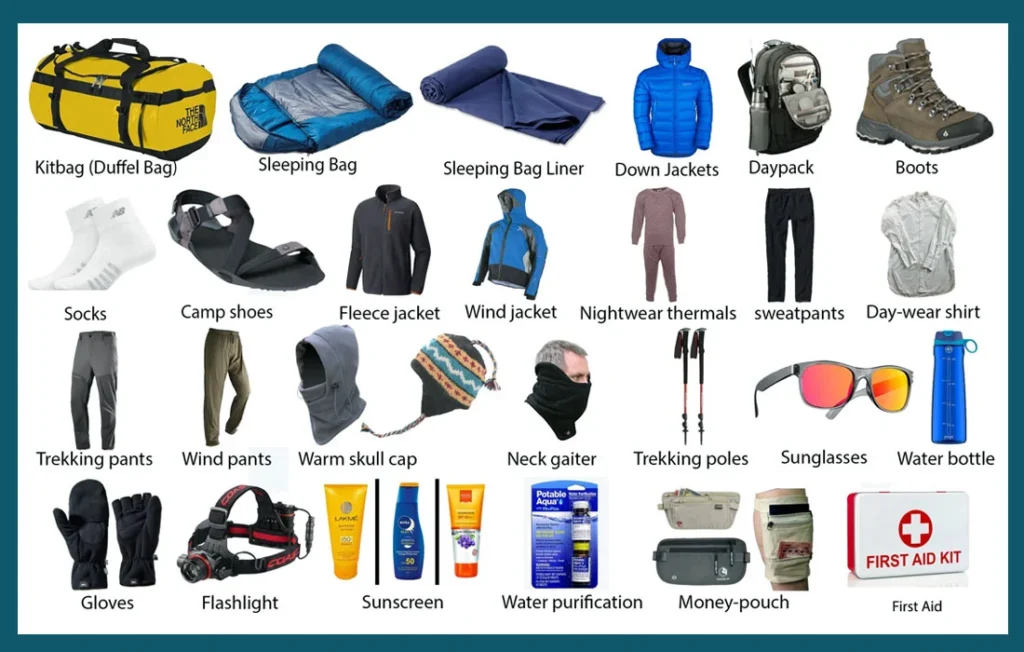
How To Reach
Pick-Up Information
- It is essential for everyone to arrive at Dehradun (06:00 am)
- Pick-up Location – Hotel Milan Palace near Railway Station,Dehradun.
- Once you have reached Dehradun, MHE will manage the rest of your travel arrangements, if you have opted for pick-up service, you can select this option during the booking process by adding it as an add-on.
Options to Reach Dehradun
First, you can arrive at Delhi, Dehradun airport or Chandigarh. The journey from these locations to Dehradun is explained below.
1. Take overnight train/bus to Dehradun.
2. Take overnight train/bus to Haridwar and drive to Dehradun (50km | 1 hr 30 min drive with normal traffic).
3. Take overnight train/bus to Dehradun.
4. Board a flight to Dehradun airport (Jolly Grant Airport) (26 km, 30 min) from Dehradun. If you’re arriving by air, then come one day in advance.
Drop-Off Information
- The designated drop-off point is same as pickup point.
- Reach in Dehradun by 6:30 to 7:30 pm.
- Please consider planning your subsequent travel arrangements after 10:00 pm.
Note – In July and August month always have a buffer day in your Itinerary due to the Monsoon.
- It’s highly advisable to keep a buffer day in your travel plan. If the buffer day is not used, it can be used to explore Dehradun/Rishikesh.
- MHE offers comfortable transportation through Tempo Traveler, Bolero, or equivalent vehicles. If you wish to upgrade your mode of transportation, please contact your trek coordinator for further assistance.
Cost Terms
✅Inclusion
Accommodation (as per the itinerary):
- Triple/quad sharing (separate for males and females throughout the trek)
Meals (Veg + Egg):
- All meals (including tea, soup, snacks, etc.) from Day 1 Dinner to Day 3 Breakfast. Morning and evening tea, accompanied by light snacks, are included in the Tungnath-Chandrashilla trekking package.
3. Support:
- 1 Versatile base camp manager handles communication and deploys extra manpower in emergencies.
- 1 Mountaineering & First aid qualified professional trek Leader.
- 1 Experienced high-altitude chef.
- Local experienced guides (Number of guides depending on the group size).
- Enough support staff.
Trek equipment:
- Sleeping bag, Sleeping liners (if required), mattresses, and Utensils.
- 3 men all season trekker tent (twin sharing), Kitchen & Dining tent, Toilet tent.
- Camping stool, Walkie talkie.
- Ropes, Helmet, Ice axe, Harness, Gaiters & crampons (if required).
5. First aid:
- Medical kit,Stretcher,Oxygen cylinder,Blood pressure monitor,Oximeter,Stethoscope.
6. Transportation (as per the itinerary). Mules/porters to carry the central luggage.
- Cloakroom facility available at the base camp for additional luggage
- All necessary permits and entry fees, Upto the amount charged for Indian
- Trek Completion Certificate.
❌Exclusion
- Insurance (Mandatory).
- Food during the transit.
- Any kind of personal expenses.
- Mule or porter to carry personal luggage.
- Emergency evacuation, hospitalization charge, etc.
- Anything not specifically mentioned under the head Inclusion.
Things can be provided on demand and availability (participant has to pay extra for these things).
- Satellite phone/set phone – is a type of mobile phone that connects via radio links via satellites orbiting the Earth instead of terrestrial cell sites like cellphones. Therefore, they can operate in most geographic locations on the Earth’s surface.
- Gamow/PAC HAPO Bag(Portable Hyperbaric Bag) – is a unique, portable hyperbaric chamber for the treatment of acute mountain sickness (AMS), also known as altitude sickness.
- AEDs (Automated External Defibrillators) are portable life-saving devices designed to treat people experiencing sudden cardiac arrest, a medical condition in which the heart stops beating suddenly and unexpectedly.
Cancellation & Rescheduling Policy
We understand that plans can change. Our policies are simple, transparent, and designed to balance your flexibility with the commitments we make to our local teams.
 Cancellation Policy
Cancellation Policy
- Cancellation requests must be made in writing via email (info@musafirhikes.com)
- The date of cancellation is the date we receive your request, not when it is sent.
Refunds
- 30+ days before trek → Full refund (minus 1.99% processing fee)
- 15–29 days before trek → 80% refund
- 10–14 days before trek → 60% refund
- 5–9 days before trek → 40% refund
- ≤4 days before trek → No refund
Rescheduling Policy
- Requests must also be made in writing (e.g., via email).
- The date of receipt determines rescheduling eligibility.
Rescheduling Fees
- 30+ days before trek → Free reschedule
- 15–29 days before trek → 10% fee
- 10–14 days before trek → 20% fee
- 5–9 days before trek → 30% fee
- ≤4 days before trek → Not possible
Notes
- Refunds are processed within 7–10 business days to the original payment method.
- Timelines are counted from the original trek start date.
- If a trek is affected by weather, natural events, or government restrictions, we will try to reschedule first. If not possible, the cancellation terms above apply.
- Bookings are non-transferable.
- Once rescheduled, treks become non-refundable.
Trek Essentials
Gallery
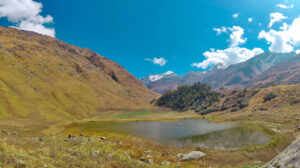
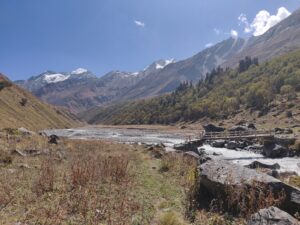
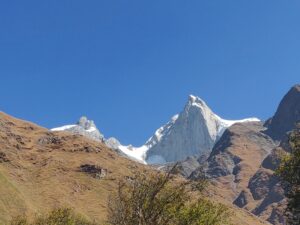
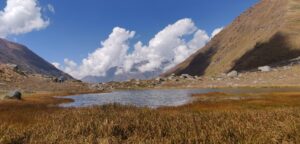
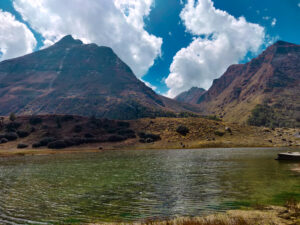
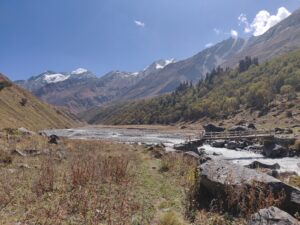
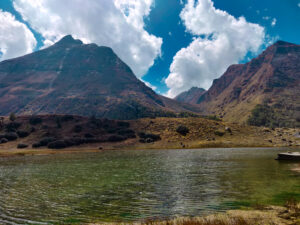
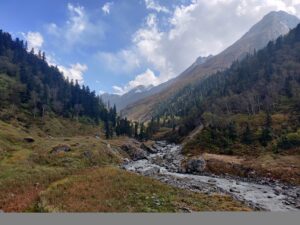
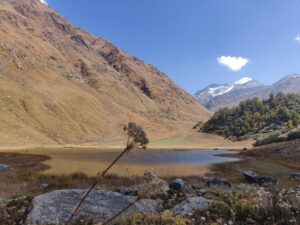
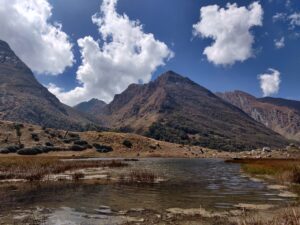
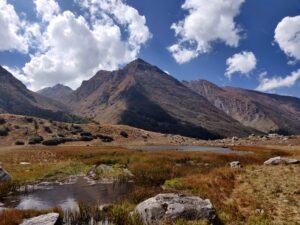
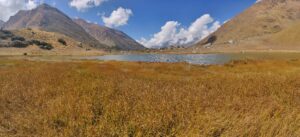
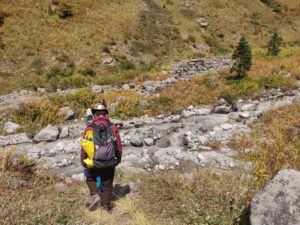
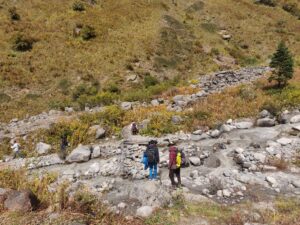
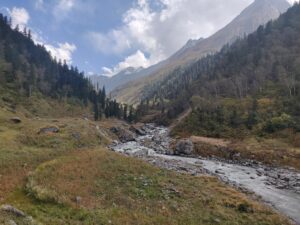
Trek Reviews




Frequently Asked Questions(FAQ)
Where will we stay during the trek?
Accommodation will be provided in tents at designated campsites. In Sankri, trekkers stay in a pre-booked guesthouse or homestay.
How many people share a tent?
Tents are provided on a twin-sharing basis. Triple sharing may be arranged if required.
What type of food will be served?
Trekkers will be served nutritious and hygienic vegetarian meals including breakfast, lunch, evening snacks, and dinner.
What is the best time for the Ruinsara Lake trek?
The ideal months are April to June (spring-summer) and September to November (autumn-winter). Avoid monsoons due to landslides
How difficult is the Ruinsara Lake trek?
It is a moderate-level trek, suitable for both beginners and experienced trekkers. Good fitness and stamina are recommended as the trek involves multiple steep climbs and long walking hours.
Where is the last ATM point, and what about network connectivity?
- Last ATM: Purola
- Network: Limited and intermittent; BSNL and Vodafone may work at Sankri.
Are washroom facilities available during the trek?
Yes. Guesthouses at Sankri have basic washrooms. During camping, toilet tents (dry pits) will be provided separately for men and women.
Is there a place to leave luggage I don’t need during the trek?
Yes. You can leave extra bags or items at Hotel, safely stored until your return. Just pack a smaller bag with essentials for trail days.
Do I need any permits for the trek?
Yes, forest entry permits for the Ruinsara Lake Trek.These are arranged by Musafir Hikes as part of your trek package. You only need to bring a government ID and passport-size photos.
Can trekking equipment be rented?
Yes, jackets, trekking shoes, hiking poles, and backpacks are available for rent.
Where will we stay during the trek?
- Day 1 & Day 5: Hotel Himalayan Bliss, Sankri
Trekking Days: Tented accommodations
How do I book a tour with Musafir Hikes?
You can book directly through our website or contact us via call/WhatsApp/email. Once you select your tour, you’ll receive a confirmation and payment details.
What is included in the tour cost?
Our tours generally include accommodation, meals (as per itinerary), guide charges, permits, and basic medical support. Exclusions usually cover personal expenses, travel insurance, and anything not mentioned in inclusions.
Is it safe to travel with Musafir Hikes?
Yes. Your safety is our top priority. We follow government trekking norms, carry first aid, and our guides are trained in mountain safety and emergency handling.
How difficult is the trek/tour? Do I need prior experience?
Difficulty varies from tour to tour. Most treks are designed for beginners with good fitness, while some require prior high-altitude experience. Fitness preparation tips are always shared after booking.
How do I prepare physically for the trek?
We recommend regular walking/jogging, stair climbing, or light cardio at least 3–4 weeks before the trek. Staying hydrated and building stamina will make your experience much easier and enjoyable.
How do I reach the starting point of the trek?
We provide details of the nearest railway station/airport and assist with travel planning. Transport from pickup points (like Rishikesh/Dehradun) is usually arranged with the group
Why should I choose Musafir Hikes?
We focus on safety, sustainability, and local community support. A part of your booking helps uplift Himalayan villages, making your journey meaningful.
